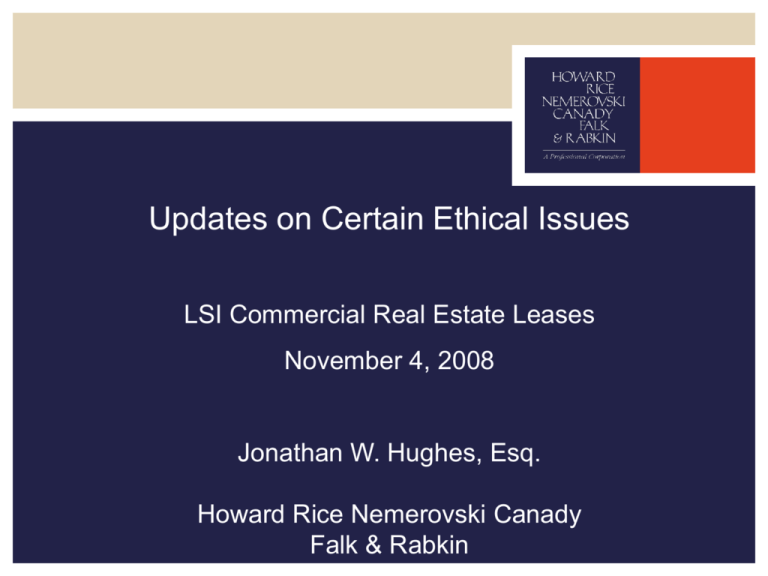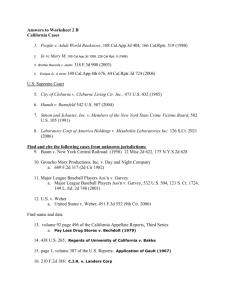aclca m 26 Hughes 10
advertisement

Updates on Certain Ethical Issues LSI Commercial Real Estate Leases November 4, 2008 Jonathan W. Hughes, Esq. Howard Rice Nemerovski Canady Falk & Rabkin Overview • Who is your client? • Entity theory of representation • When is “duty to warn” triggered? • Representing constituents of a corporation • Ex parte ethics rules Fiduciary Duties Owed to Clients • Undivided Loyalty • Candor • Communication • Competence • Confidentiality • Zealousness 3 Always Know Who Your Client Is • You owe your fiduciary duties to your client and only your client • If don’t know who client is, hard to comply with your fiduciary duties • So — who is your client? 4 Good News • You can decide • You can control • But if you don’t, likely to be sorry What Are The Rules? • Entity theory of representation: most states follow this theory • Entity theory: when you represent an entity, your client is the entity, not its “constituents” • Constituents: officers, directors, shareholders, members, managers, and employees 6 California Rule 3-600(A) In representing an organization, an attorney shall conform his or her representation to the concept that the client is the organization itself, acting through its [authorized representatives] overseeing the particular engagement 7 California Case Law Is Also Clear The corporation is the client, not the officers, directors, shareholders or employees Meehan v. Hopps, 144 Cal. App. 2d 284, 293 (1956); Skarbrevik v. Cohen, England & Whitfield, 231 Cal. App. 3d 692, 704 (1991) 8 Not Even The Board Is Your Client • The client is the fictitious corporate entity • The Board is just a group charged with managing the entity • You advise the Board, but you represent the entity Skarbrevik v. Cohen, England & Whitfield, 231 Cal. App. 3d 692, 704 (1991) 9 What About? • Associations • LLCs • Partnerships 1 0 Associations • Representation of homeowners association does not include representation of the homeowners (Smith v. Laguna Sur Villas Community Ass’n, 79 Cal. App. 4th 639, 644 (2000)) • However, court may find otherwise depending on the facts (see Benge v. Superior Court, 131 Cal. App. 3d 336, 347-48 (1982), attorney-client privilege applied to union members) Partnerships • You can specify who client is • If you don’t: whether you represent the partnership or individual partners will be decided on a case-by-case analysis Responsible Citizens v. Superior Court, 16 Cal. App. 4th 1717, 1731-33 (1993); Buehler v. Sbardellati, 34 Cal. App. 4th 1527 (1995) Partnerships • Partnership v. limited partner • Law murky Johnson v. Superior Court, 38 Cal. App. 4th 463 (1995) Be Clear About Who Is NOT Your Client • In your own mind • In your dealings with others associated with the entity you represent (Rule 3-600(D)) • In your dealings with third parties • Create a written record — be sure it gets to the right parties HOW DOES RULE 3-600(D) WORK? The “Duty To Warn” A Constituent That You Do Not Represent Him Or Her • Is there such a duty? • When is it triggered? California Rule • Rule 3-600(D): – When dealing with an organization’s directors, officers, employees, members, shareholders or other constituents – an attorney shall explain the identity of the client for whom the member acts – whenever “it is or becomes apparent that the organization’s interests are or may become adverse to those of the constituents with whom the attorney is dealing” Practice Pointers for Rule 3-600(D) • Must explain who you represent • Do not behave as if you represent constituents • Do not give personal advice • Other steps you can take May Represent Constituent Along With Organization: Rule 3-600(E) • Attorney representing an organization may also represent its constituents • BUT representation of constituents is subject to the conflicts rules (Rule 3-310) Representing Constituents of Entity Client • You need to analyze conflicts • Actual or potential — Rule 3-310(C)(1)-(2) If Conflict Waiver Is Required • If the entity’s consent is required; consent shall be given by someone other than the constituent to be represented, or by the shareholder(s) or organization members (Rule 3-600(E)) Who Is Paying Your Fees? If someone other than the client is paying your fees, comply with Rule 3-310(F): • Disclose situation to client in writing • Obtain client’s informed written consent • Protect privileged and confidential information • Don’t let payor interfere • Application to joint client situation CONTACTING REPRESENTED PARTIES: CALIFORNIA EX PARTE ETHICS RULES California Rules of Professional Conduct, Rule 2-100(A) “While representing a client, a member shall not communicate directly or indirectly about the subject of the representation with a party the member knows to be represented by another lawyer in the matter, unless the member has the consent of the other lawyer.” Purpose of “no contact” rule • To protect a represented person from possible overreaching by other lawyers in the matter • To prevent interference in opposing party’s attorneyclient relationship • To prevent the uncounselled disclosure of privileged information ABA Model Rule 4.2 Comment [1] Not limited to litigation • “As used in paragraph (A), ‘the subject of the representation,’ ‘matter,’ and ‘party’ are not limited to a litigation context.” Rule 2-100 Discussion If Rule 2-100 applies, • Consent of the other lawyer is required • Consent of the opposing party is not enough Every kind of direct or indirect communication is prohibited • Speaking in person • Letters • Emails • Phone calls “Knows to be represented”-Actual knowledge required • California Rule 2-100 not triggered unless attorney actually knows the contacted party is represented • If no reason to believe, no duty to inquire • However, actual knowledge may be established by circumstantial evidence where attorney has “reason to believe” party is represented; can’t “clos[e] eyes to the obvious” Snider v. Superior Court, 113 Cal. App. 4th 1187, 1209, 1215-16 (2003); ABA Rule 4.2, Comment [8] A party includes • Current officer, director or managing agent of corporation • Current partner or managing agent of partnership • Current association member or employee of entity – where subject of communication is act or omission by person that may be binding on or imparted to entity in connection with matter in dispute, or – whose statement may constitute an admission on behalf of the corporation Rule 2-100(B) Current Corporate Officers or Directors Contact with corporate officers and directors of adverse corporate party is improper • Even if not in the “control group” • Even if in dispute with corporation (see Mills Land & Water Co. v. Golden West Refining Co., 186 Cal. App. 3d 116, 127-29 (1986), decided under former rule) However, contact with dissident officer or director ok if represented by separate counsel who consents • It is “advisable and prudent,” however, to get consent of corporate counsel, too La Jolla Cove Motel & Hotel Apts., Inc. v. Superior Court, 121 Cal. App. 4th 773, 789-90 (2004) Managing Agents • Employees who “exercise substantial discretionary authority over decisions that determine organizational policy” are managing agents Snider v. Superior Court, 113 Cal. App. 4th 1187, 1209 (2003) Current Employees Rule 2-100(B)(2): contact with employees is prohibited • “If the subject of the communication is any act or omission of such person in connection with the matter which may be binding upon or imputed to the organization for purpose of civil or criminal liability,” or • If the employee’s statement constitutes “an admission on the part of the organization” Contact with current employees also prohibited if employee is • Separately represented • An officer • A director • A managing agent Employees However, mere fact corporation has in-house counsel not enough to constitute “actual knowledge” Former officers and employees • Ok to communicate with unrepresented former employees of a corporation without the consent of the attorney representing the corporation. Continental Ins. Co. v. Superior Court, 32 Cal. App. 4th 94, 118-19 (1995) • But not ok to inquire about privileged communications. State Farm Fire & Casualty Co. v. Superior Court, 54 Cal. App. 4th 625, 652 (1997) Experts • Not a “party” under Rule 2-100 • But not ok to contact opposing party’s experts without counsel’s permission, even if expert was only interviewed — and not retained — by opposing party See Shadow Traffic Network v. Superior Court, 24 Cal. App. 4th 1067, 1084-85 (1994) Direct communication among parties themselves ok “Rule 2-100 is not intended to prevent the parties themselves from communicating with respect to the subject matter of the representation, and nothing in the rule prevents a member from advising the client that such communication can be made.” Rule 2-100 Discussion Exceptions Rule 2-100(C) permits communications with represented party if: • “with a public officer, board, committee, or body” • “initiated by a party seeking advice or representation from an independent lawyer of the party’s choice” or • “otherwise authorized by law” Consequences of violating Rule 2-100 • State Bar discipline • Possible disqualification • Usually not vicarious disqualification of entire firm




